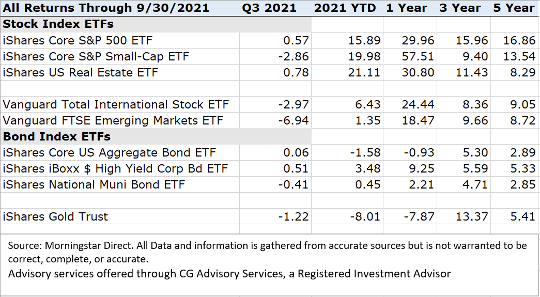The third quarter of 2021 was a roller-coaster for stocks, mostly climbing, then descending back to a similar level as they started. The US Aggregate Bond Index similarly finished near the same price as it started. International stocks fell, led by emerging markets.
The big driver of volatility in US markets can be focused on disfunction in DC, as a government shutdown was narrowly averted. Washington DC’s inability to conduct regular tasks, in favor of brinksmanship and grandstanding, is hindering the bond market and entire global economy. Regardless of political leanings, we all need our government to come to an agreement on budgets and ensure the daily operations of the country are met. We have played this game in the mid-90s, and again in 2013. The debt ceiling has been raised nearly 100 times since WWII. It’s worth noting that this is just to fund existing obligations, not authorize future spending increases.
What can history teach us about these events from the past?
It causes volatility! The “fiscal cliff” scare back in 2011 ended up causing a 19% drop in the S&P 500. The calendar year ended just in the red, down about a percent.
Is this a reason to change investment strategy?
Probably not. The S&P 500 is up over 200% since the start of 2011. The speed and magnitude of these corrections is tricky to get right. The cost of missing out on long term growth, waiting for the right buying opportunity, could be far worse than seeing a bad statement or two.
Emerging Markets indices were the lowest performers of those reported below. China was the main culprit, as they are clamping down on tech businesses that have become large enough to threaten the Chinese Communist Party. There are obvious conflicts of interest between wildly profitable business and a “communist” government. They have managed to cohabitate for years (while barring US equivalents). This does highlight a growing trend in emerging markets, a push back against open markets and democracy. Russia, India, Turkey and Brazil are other large emerging markets countries that have been trending in the wrong direction over the previous years.
Being that these are the fastest growing economies, largest population bases, and have the best population demography; they warrant some exposure in a well-diversified portfolio. However, the allocation to emerging markets was reduced in growth-oriented strategies at the turn of the quarter.
This material represents an assessment of the market and economic environment at a specific point in time and is not intended to be a forecast of future events, or a guarantee of future results. Forward-looking statements are subject to certain risks and uncertainties. Actual results, performance, or achievements may differ materially from those expressed or implied. Information is based on data gathered from what we believe are reliable sources. It is not guaranteed as to accuracy, does not purport to be complete and is not intended to be used as a primary basis for investment decisions. It should also not be construed as advice meeting the particular investment needs of any investor.
*Past performance does not guarantee future results. Investing involves risk, including the loss of principal.
*The Standard & Poor’s 500 (S&P 500) is an unmanaged group of securities considered to be representative of the stock market in general. It is a market value weighted index with each stock’s weight in the index proportionate to its market value.
*Neither Asset Allocation nor Diversification guarantee a profit or protect against a loss in a declining market. They are methods used to help manage investment risk.




